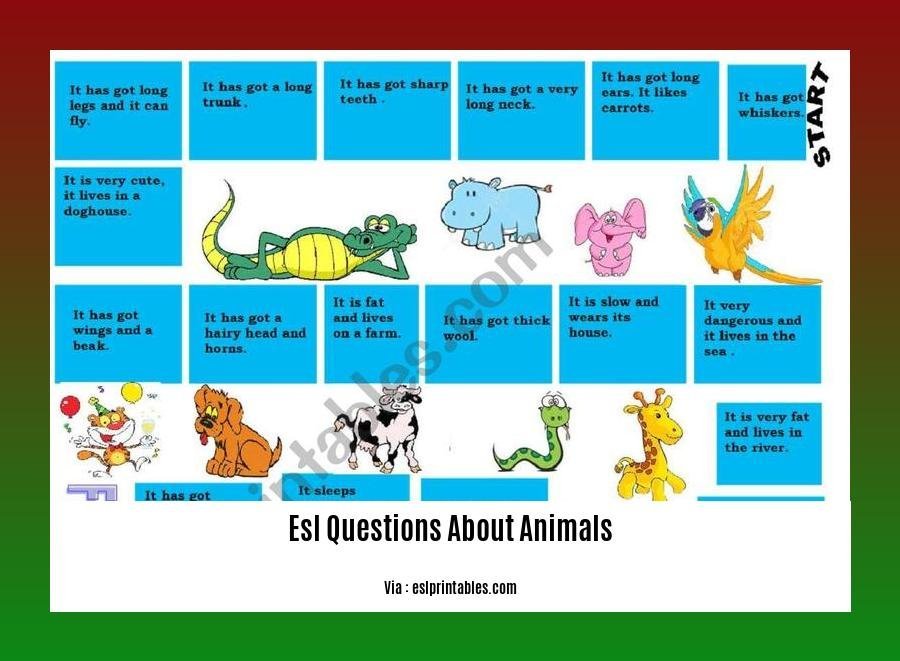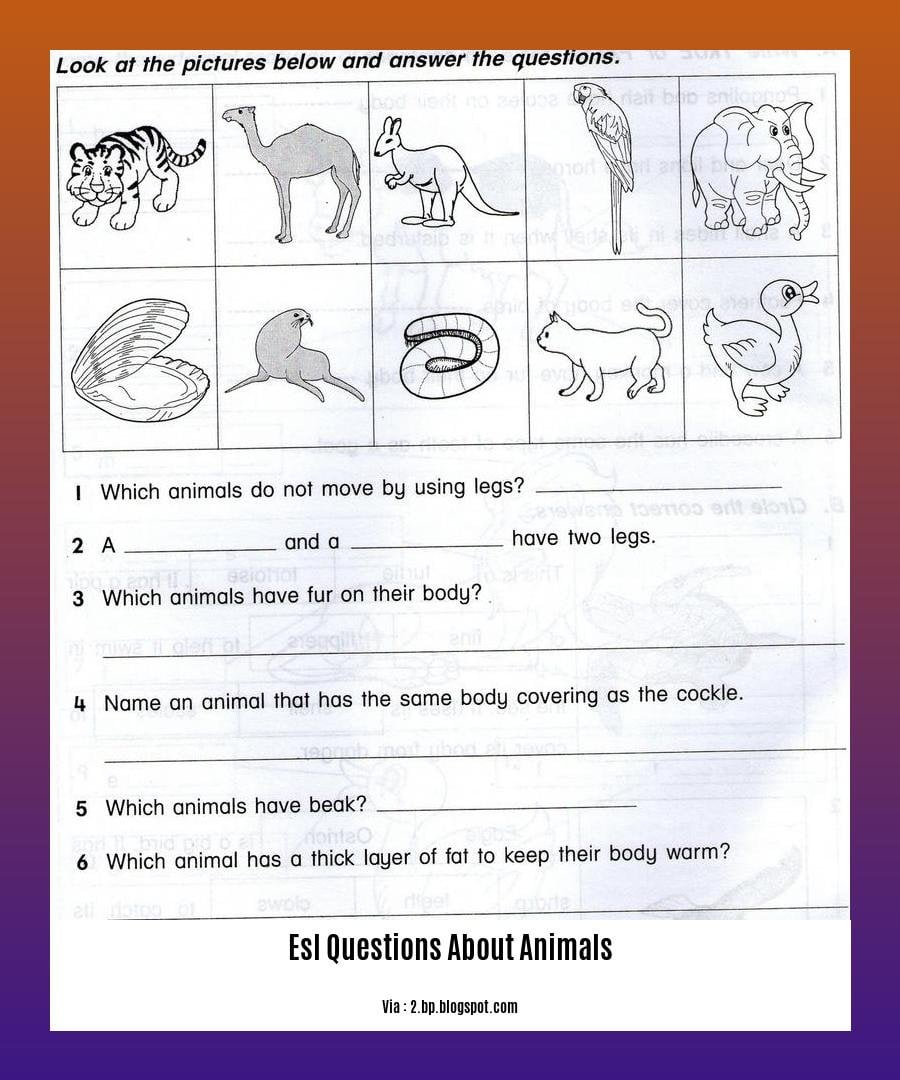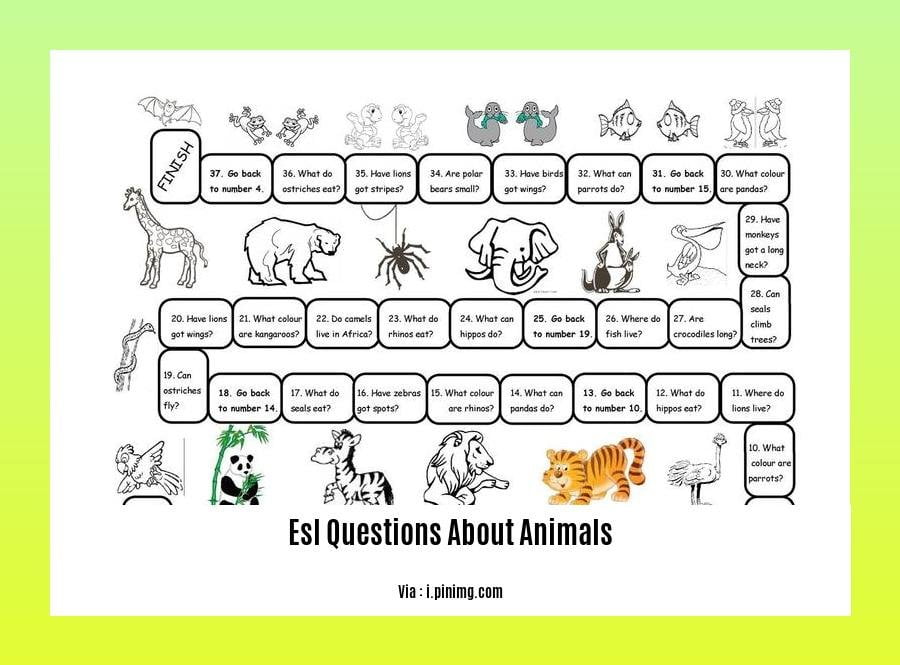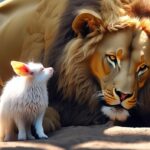Engaging ESL Questions About Animals: Igniting Curiosity and Language Fluency
Are you ready to embark on an exciting journey through the animal kingdom? In this article, we will explore a range of thought-provoking questions designed to stimulate curiosity and enhance language fluency for ESL learners. Whether you are a teacher looking for engaging classroom activities or a student eager to expand your English skills, these animal-themed questions will ignite your interest and encourage lively discussions. Join us as we delve into the fascinating world of animals and discover how they can inspire language fluency.
Key Takeaways:
- ESL questions about animals are used to practice English speaking and writing skills related to animals.
- Examples of ESL questions about animals include favorite animals, animals that represent oneself, pets, ways to save endangered species, experiences at aquariums, fears of creatures, opinions about zoos, encounters with wild animals, and hypothetical choices of becoming an animal.
- Useful traits that help animals survive include characteristics like a giraffe’s long neck.
- Source 1: “190 ESL conversation questions about animals” from learnenglisheveryday.com
- Source 2: “ESL Questions About Animals [Updated]” from eslquestionsabout.com
ESL Questions About Animals

Are you ready to dive into the fascinating world of animals while improving your English skills? In this article, we will explore a variety of ESL questions about animals that will not only spark your curiosity but also enhance your language fluency. Whether you are discussing your favorite animals, pondering the ethics of zoos, or imagining life as a creature, these engaging questions will provide a platform for lively discussions and meaningful language practice.
Favorite Animals
What is your favorite animal? Share with your partner why you find this animal intriguing or appealing.
If you could be any animal for a day, which animal would you choose? Explore the characteristics and behaviors of your selected animal and discuss why you would like to experience life as that creature.
Animals that Represent Oneself
If you were an animal, which animal would best represent your personality? Explain the traits and qualities that align with your chosen animal and how they reflect your own characteristics.
Why do you think certain animals are commonly associated with specific personality traits, such as lions for bravery or owls for wisdom? Explore cultural beliefs and personal interpretations.
Pets
Do you have any pets? If yes, what kind of pet(s) do you have? If you don’t have any pets, discuss which animal you would choose and why.
What are some responsibilities that come with owning a pet? Share your thoughts on the importance of providing proper care and attention to pets.
Ways to Save Endangered Species
What can individuals do to help protect endangered species? Discuss actions that can be taken at both individual and community levels.
Why is it important to preserve biodiversity and protect all species, including those that are not as iconic or well-known? Explore the interconnectedness of different species and the overall balance of ecosystems.
Experiences at Aquariums
Have you ever visited an aquarium? If yes, share your favorite memories or observations. If no, discuss your interest in visiting one and what you hope to see.
How do you feel about keeping marine animals in captivity for educational or entertainment purposes? Discuss the pros and cons of aquariums and their impact on marine life.
Fears of Creatures
Do you have any specific fears or phobias related to animals? Share your experiences and discuss how common or uncommon these fears are.
What strategies can be employed to overcome fears of certain animals or insects? Explore different techniques and share personal anecdotes.
Opinions about Zoos
What are your thoughts on zoos? Do you think they are necessary or should they be abolished? Engage in a thoughtful discussion about the ethical considerations and educational value of zoos.
Are there any alternatives to traditional zoos that can provide educational opportunities without compromising animal welfare? Brainstorm innovative approaches to animal conservation and education.
Encounters with Wild Animals
Have you ever encountered a wild animal in its natural habitat? Share your experiences and discuss the feelings and thoughts that arise during such encounters.
What precautions should people take when encountering wild animals to ensure their safety? Discuss responsible behavior in natural environments and the importance of respecting wildlife.
Hypothetical Choices of Becoming an Animal
If you had the opportunity to transform into any animal, which would you choose? Engage in a vibrant discussion about the advantages and disadvantages of different animals and their unique abilities.
What challenges and benefits do animals face in the wild compared to life in captivity? Explore the complexities of animal habitats and the impact of human intervention.
Explore these ESL questions about animals and dive into captivating conversations with your classmates or language exchange partners. Remember, the key to improving your language skills is to actively participate and engage with the topics that interest you. So let your curiosity soar as you explore the wonders of the animal kingdom while honing your English fluency!
Here are some examples of endangered species in the Philippines. If you’re curious to know more, click here to explore further.
Discover the fascinating world of extinct plants in India with names that will leave you in awe. Dive into the realm of botanical wonders by clicking here.
Habitats and Adaptations of Animals
Animals are fascinating creatures that inhabit diverse ecosystems around the world. From the lush rainforests to the barren deserts, each animal has adapted to its specific environment in order to survive. Understanding the habitats and adaptations of animals not only provides valuable knowledge but also enhances language fluency for ESL learners. Let’s explore some engaging ESL questions about habitats and adaptations of animals to ignite curiosity and language skills.
Beginner Questions
- What is a habitat? Can you think of some examples?
A habitat is the natural environment where an animal lives. It provides the necessary food, water, shelter, and other resources to support the animal’s survival. For example, a fish lives in a water habitat, while a bear lives in a forest habitat.
What are some adaptations animals have for surviving in different habitats?
Animals have developed various adaptations to survive in their habitats. For instance, a camel has long eyelashes and the ability to store water in its hump to withstand the arid desert. A polar bear has a thick layer of blubber and white fur to blend in with the snowy Arctic environment.
Can you think of an animal and describe how it is adapted to its habitat?
Choose an animal of interest and describe the specific adaptations it has for its habitat. For example, the chameleon has the ability to change its skin color to match its surroundings, allowing it to hide from predators and sneak up on prey in its forest habitat.
What challenges do animals face in their habitats? How do they overcome these challenges?
- Animals face various challenges in their habitats, such as finding food, avoiding predators, and coping with extreme weather conditions. Some animals have developed specialized behaviors, physical features, or survival strategies to overcome these challenges. For instance, birds migrate to warmer areas during winter to find food and escape the cold.
Intermediate Questions
- What role do habitats play in the survival of endangered species?
Endangered species are animals at risk of extinction. Discuss the importance of preserving their habitats to ensure their survival. For example, protecting the rainforest habitat not only benefits the endangered orangutan but also helps maintain the entire ecosystem’s balance.
How do animals adapt to extreme habitats, such as the deep ocean or the high mountains?
- Extreme habitats present unique challenges, such as pressure in the deep ocean or low oxygen levels in high mountains. Explore the adaptations of animals that allow them to thrive in these extreme environments. For example, deep-sea creatures have bioluminescent adaptations to attract prey or communicate in the darkness.
Key Takeaways:
- Habitats refer to the natural environments where animals live and obtain resources for survival.
- Animals have evolved adaptations to suit their specific habitats, such as camouflage, physical features, or behaviors.
- Animals face challenges in their habitats, such as finding food, avoiding predators, and surviving extreme weather conditions.
- Preserving habitats is crucial for the survival of endangered species and maintaining the balance of ecosystems.
- Extreme habitats require unique adaptations from animals to cope with harsh conditions.
- Understanding habitats and adaptations enhances language fluency and nurtures a deeper appreciation for the animal kingdom.
Sources:

- National Geographic: Habitats
- TED-Ed: How do animals survive in the deep ocean? – Kate S. Sparks
Animal Behaviors and Communication
Animals are fascinating creatures that communicate in unique ways. Understanding animal behaviors and communication can not only deepen our appreciation for them but also provide interesting topics for ESL learners to explore. In this instructional guide, we will delve into the various ways animals communicate and engage in behaviors, sparking curiosity and fostering language fluency.
Animal Behaviors: Insights into the Animal Kingdom
Animals exhibit a wide range of behaviors, from hunting and gathering to nurturing their young. By observing and studying these behaviors, we can gain insights into their natural instincts and survival strategies. Here are some highlights of animal behaviors:
Social Behavior: Many animals, such as elephants and wolves, live in social groups where they communicate and cooperate with each other. They establish hierarchies, care for their young collectively, and engage in activities that promote group cohesion.
Migration: Some animals, like birds and whales, undertake long-distance migrations, traveling thousands of miles in search of food, mating grounds, or suitable habitats. The ability to navigate and communicate effectively is crucial for the success of these journeys.
Territorial Defense: Animals often mark and defend their territories using various methods, such as scent marking, vocalizations, and displays of aggression. These behaviors help establish boundaries and prevent conflicts with neighboring individuals or groups.
Courtship Displays: Many species engage in elaborate courtship displays to attract mates. These displays can include intricate dances, vibrant plumage or fur, and melodious songs. By observing these behaviors, ESL learners can explore the diversity of mating rituals in the animal kingdom.
Animal Communication: Unlocking the Language of Animals
Communication is essential for animals to convey messages, establish social bonds, and coordinate group activities. While animals may not communicate through spoken language as humans do, they have developed fascinating ways to express themselves. Here are some notable forms of animal communication:
Vocalizations: Animals like birds, whales, and primates use vocalizations to communicate with their peers. From melodic bird songs to the complex communication of dolphins, ESL learners can explore the rich auditory world of animal communication.
Body Language: Animals use their bodies and gestures to convey messages. For example, a bear may raise its paw as a sign of dominance or playfulness, while a dog may wag its tail to express joy or excitement. Understanding these non-verbal cues can help ESL learners improve their observational skills and enhance their comprehension of the animal world.
Chemical Signals: Animals release pheromones, chemical substances that serve as signals to convey information about mating availability, territory marking, and social status. ESL learners can explore how pheromones play a significant role in the animal kingdom and delve into specific examples of pheromone-based communication in different species.
Visual Displays: Many animals engage in visually striking displays to communicate messages. For instance, peacocks flaunt their vibrant plumage to attract mates, while bees perform intricate dances to communicate the location of food sources. These visual displays offer exciting topics for ESL discussions on animal behavior and communication.
Key Takeaways:
- Animal behaviors provide insights into their survival strategies and natural instincts.
- Animals communicate through vocalizations, body language, chemical signals, and visual displays.
- Understanding animal behaviors and communication enhances language fluency and fosters curiosity about the animal kingdom.
- Observing and studying animal behaviors can deepen our appreciation for the diversity and complexity of the animal world.
Sources:
- ESL Questions About Animals [Updated]
- Learn English Every Day – 90 ESL conversation questions about animals
Incorporating engaging discussions and inquiry-based activities on animal behaviors and communication can provide ESL learners with valuable language practice opportunities. By exploring topics such as animal social behavior, migration, courtship displays, and the various modes of animal communication, students can enhance their language skills while developing a deeper appreciation for the rich tapestry of the animal kingdom. So, let’s dive into the world of animal behaviors and communication, igniting curiosity and fostering language fluency.
Human Impact on Animals and Conservation Efforts
As humans, our actions have a significant impact on the world around us, including animals and their habitats. This article will explore the various ways in which human activities affect animals and the importance of conservation efforts in mitigating these impacts. We will delve into the key causes of endangerment, the consequences of pollution and waste, and the significance of protecting endangered species for biodiversity and ecological balance.
Causes of Endangerment
Endangered species are at risk of extinction, and their decline is often attributed to human actions. Habitat loss, pollution, climate change, illegal hunting, and poaching are all factors contributing to the endangerment of animal species. Tigers and rhinos are examples of animals whose populations have been drastically reduced due to human activities. It is crucial to understand these causes and their implications in order to address the root causes of endangerment and take appropriate conservation measures.
Protecting Endangered Species
Conservation efforts play a vital role in protecting endangered animals and preserving biodiversity. While these efforts may sometimes have negative consequences for local industries, it is important to recognize that the long-term benefits outweigh the short-term costs. Displaced workers often turn to illegal means of income, such as poaching, when their livelihoods are disrupted. By implementing conservation measures, we not only protect individual animals but also their habitats, which are crucial for their survival.
Pollution and Waste
Pollution and waste produced by humans also have a detrimental impact on animals. Water bodies, for example, are affected by pollution and can lead to the decline of fish populations in rivers. Additionally, the waste we generate can harm marine life and other animals that come into contact with it. Addressing these issues requires a collective effort to reduce pollution, properly manage waste, and promote sustainable practices that minimize harm to animals and their habitats.
The Importance of Wildlife Conservation
Conserving wildlife is not only important for the well-being of animals but also for maintaining the ecological balance of our planet. Each species has a unique role to play in the ecosystem, and when a species becomes extinct, it disrupts the delicate balance of nature. Preservation of biodiversity is vital for the sustainability of our planet and ensuring the prosperity of future generations.
Key Takeaways:
- Human activities such as habitat loss, pollution, climate change, illegal hunting, and poaching contribute to the endangerment of animal species.
- Conservation efforts are crucial for protecting endangered animals and preserving biodiversity.
- While these efforts may have short-term costs for local industries, the long-term benefits outweigh them.
- Pollution and waste produced by humans have a detrimental impact on animals and their habitats.
- Preserving wildlife is important for maintaining the ecological balance and biodiversity.
Sources:
1. IELTS Simon
2. Live Custom Writing
FAQ
Q1: What are some examples of beginner ESL writing questions about animals?
A1: Some examples of beginner ESL writing questions about animals are: “What is your favorite animal? Describe it in detail,” “Do you have any pets? If yes, what kind of animal is it? Describe its appearance and personality,” “What is your favorite animal sound? Can you imitate it,” “Have you ever seen an animal in the wild? Describe the experience,” and “Are there any animals that scare you? Why?”
Q2: What are some examples of intermediate ESL writing questions about animals?
A2: Some examples of intermediate ESL writing questions about animals are: “Tell a story about a time when you encountered an interesting animal,” “Do you think animals should be kept in zoos? Why or why not,” “If you could be any animal for a day, which animal would you choose and why,” “What are some ways that humans can protect endangered species,” and “How do animals adapt to survive in their habitats?”
Q3: Are there any resources available for ESL reading activities about animals?
A3: Yes, there are resources available for ESL reading activities about animals. Some examples include a lesson plan from Linguahouse that introduces students to different animals and their habitats, a worksheet from iSL Collective that provides practice in identifying animal habitats, and reading passages about animals from Super Teacher Worksheets that discuss different animals and their adaptations to survive in their environments.
Q4: Where can I find more ESL questions about animals?
A4: You can find more ESL questions about animals on websites such as ESL Questions About Animals [Updated], ESL Vault, and Learn English Every Day. These websites provide a variety of questions ranging from favorite animals and pets to experiences at aquariums and zoos.
Q5: Why is it important to protect endangered species?
A5: It is important to protect endangered species for several reasons. By preserving endangered species, we are preserving biodiversity and maintaining the ecological balance. Endangered species also play a crucial role in ecosystems, and their loss can have far-reaching effects on the environment. Additionally, many endangered animals have cultural, economic, and scientific value, making their protection essential for future generations.









